By Katy Gorsuch
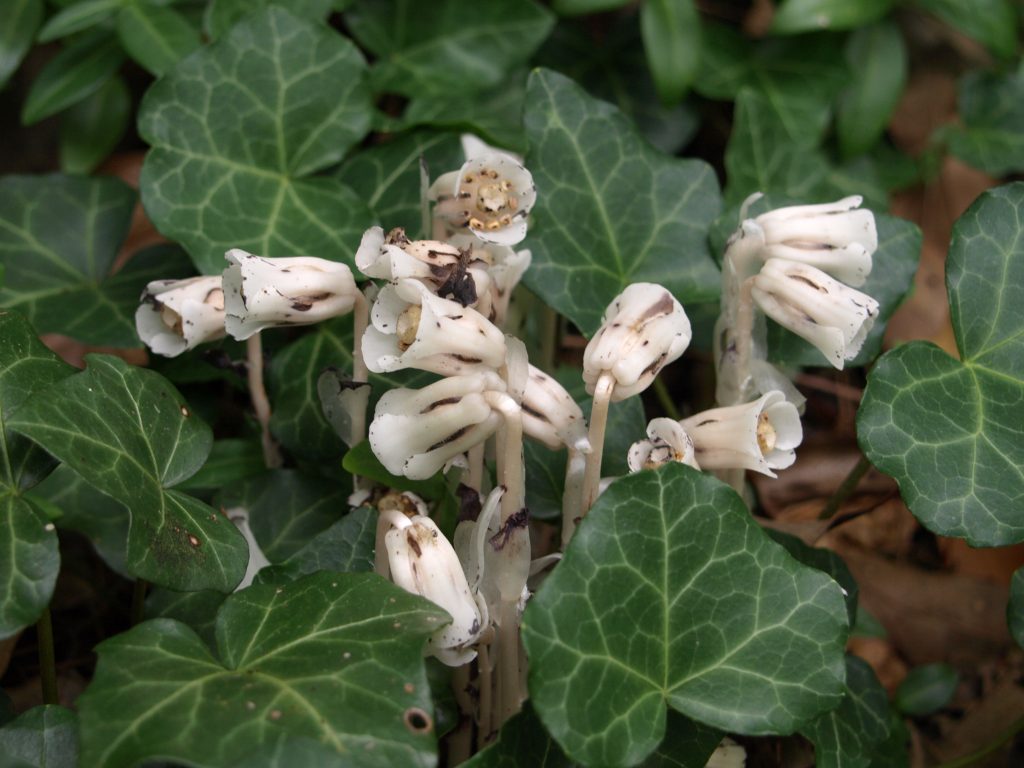
Indian Pipe. Photo by Julie Bradbury
What’s pale like a mushroom, but has flowers like a plant? It isn’t a riddle, but if you happen to see this unusual and ghostly member of the plant kingdom while hiking you may feel that way.
Monotropa uniflora goes by many names; ghost flower, ghost or corpse plant, ghost pipe, or pipe plant, with some historic sources occasionally referring to it as ice plant. Most of the wildflower’s names refer to its white or pink-white color, or its pipe-like shape, although the name “ice flower” also refers to its delicate nature. John Gunn’s 1864 work Gunn’s New Family Physician notes: “The whole plant is a pure white, and so tender and succulent, that if handled and rubbed a little, it will melt or soften, almost like ice.”
Although there are many other species that go by similar names to the plant’s most common name of “ghost flower,” the plant we are discussing here is a small flowering plant that only reaches 2 inches to a foot in height, with a bell-shaped, downturned flower. Unlike other corpse plants, M. uniflora does not have a strong scent, although this does not deter bumblebees, which are their primary pollinator. After pollination, the seeds in the flower ripen, the head of the flower turns upwards, and the ghost flower loses its more recognizable “nodding” appearance. The flower turns brown or black as it ages, drying where it stands and leaving the dry capsule of seeds for the next growth cycle.
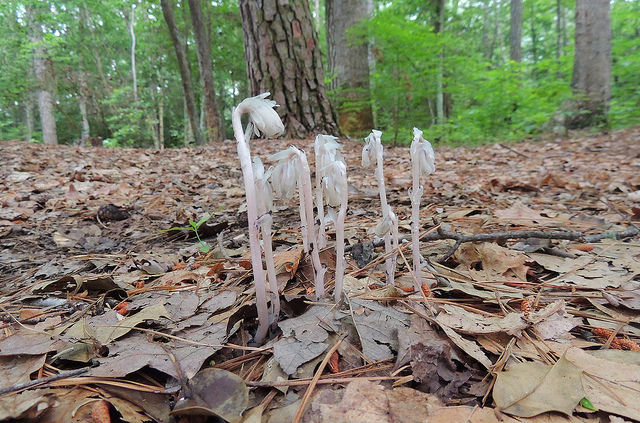
Indian Pipe in Worcester Co., Maryland (6/25/2013). Media by Scott Housten via Maryland Biodiversity Project
Ghost flower does not produce chlorophyll, the pigment that makes most plants green, and due to this appears white, or white-pink, with black flecks. Chlorophyll may be familiar as the pigment in plants which produces glucose from sunlight via the process of photosynthesis. Any living thing that produces its own food is considered an autotroph (“self-feeding”), and this includes most plants. Plants that don’t photosynthesize may be mycotrophic (“fungi-feeding”). Because they can’t produce their own food they must get their energy from another source, in this case from the fungi around them. The fungi themselves have a relationship with nearby trees, getting their energy from the trees while providing nutrients from the soil in return. This complex network of fungi which forms a mutually beneficial relationship with trees is known as mycorrhiza. Ghost flowers act as parasites to the mycorrhizal network, drawing their nutrients from the Russula fungi.
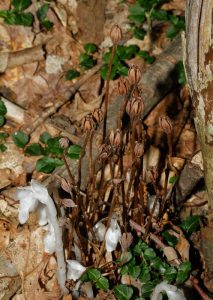
Indian Pipe (past) in Garrett Co., Maryland (7/13/2014). Media by Bill Hubick via Maryland Biodiversity Project
Due to their need to feed off other species, ghost flowers are most often found in woodlands; forest conditions provide the fungi and trees they feed from the best environment to grow. They tolerate humidity well, and may be found in coniferous, deciduous, or mixed forests, where they show a strong preference for shade. The species has three separate ranges in North America, Central and South America, and Asia. The plants in these ranges are genetically distinct from one another, which may have developed over time due to the geographical gaps between their ranges. Ghost flowers are members of the heather family (Ericaceae), which also includes blueberries and cranberries, and many of which also have relationships with fungi (in fact, ericoid mycorrhiza is a field of study all its own).
In Maryland, one can see the ghost flower most commonly starting in May, with observations of the plant rising through the summer followed by a steep drop in August. Wet weather usually prompts growth, so until November there is still a modest chance of seeing this ghostly plant.
While ghost flower populations are considered secure in Maryland, the best time to preserve a species is before it becomes threatened. The most important thing you can do to help this unique species in our area is simply leaving the plant alone. Ghost flowers are incredibly delicate, and are notorious for their ability to easily bruise, so don’t touch the plant if you see one! Likewise, due to their dependent relationship with mycorrhiza, they cannot be cultivated in a container and will die if removed from the ground. In fact, even in the lab, botanists have been able to cultivate sprouts only in highly specific conditions, with one of their most notable plants producing just seven sprouts after six months.
So if you see this ephemeral member of the plant kingdom this fall, enjoy the spectral sight before it fades into dormancy for the winter!
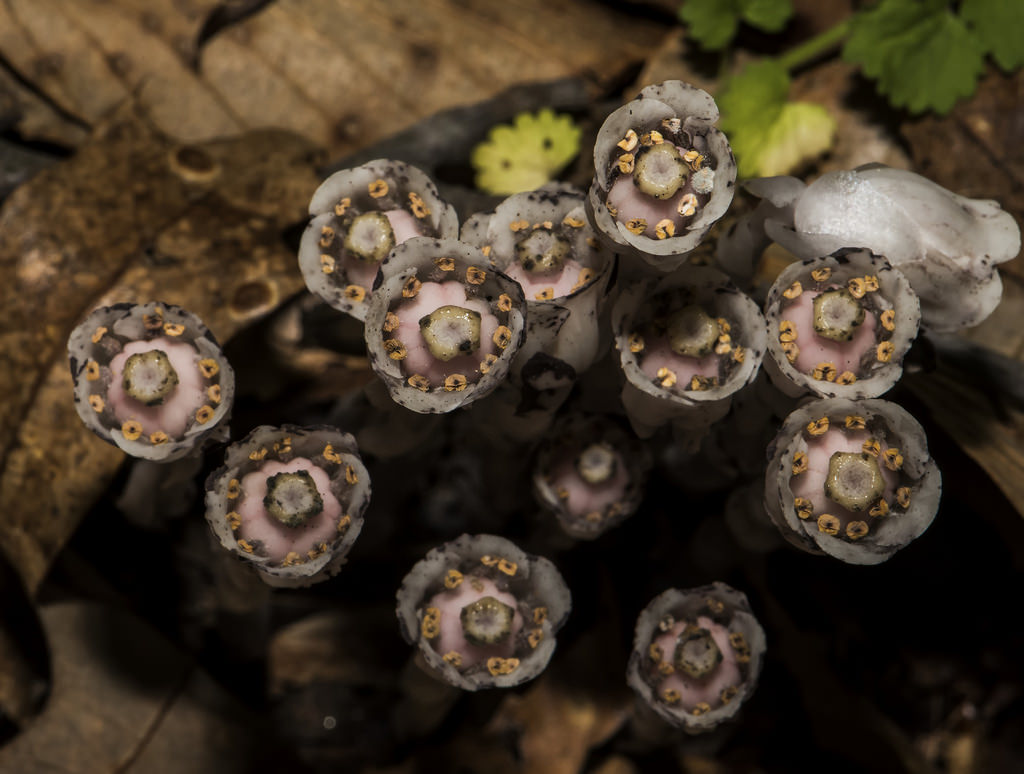
Indian Pipe (flowers standing erect) in Howard Co., Maryland (6/20/2015).
Media by Richard Orr via Maryland Biodiversity Project.
For more information about this unusual plant:
Monotropa uniflora – Ghost Plant, Indian Pipe
A close relative of ghost flower is sweet pinesap (Monotropsis odorata) – a sweet smelling plant whose scent has been compared to cinnamon or violets. The species is Endangered in Maryland.
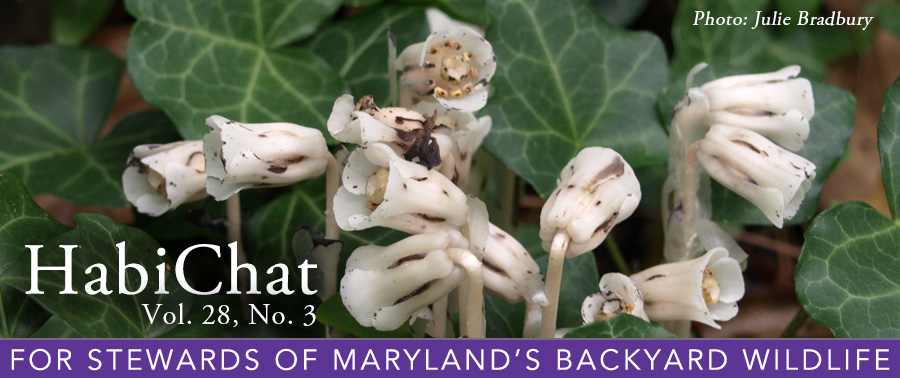

Indian Pipe. Photo by Julie Bradbury
What’s pale like a mushroom, but has flowers like a plant? It isn’t a riddle, but if you happen to see this unusual and ghostly member of the plant kingdom while hiking you may feel that way.
Monotropa uniflora goes by many names; ghost flower, ghost or corpse plant, ghost pipe, or pipe plant, with some historic sources occasionally referring to it as ice plant. Most of the wildflower’s names refer to its white or pink-white color, or its pipe-like shape, although the name “ice flower” also refers to its delicate nature. John Gunn’s 1864 work Gunn’s New Family Physician notes: “The whole plant is a pure white, and so tender and succulent, that if handled and rubbed a little, it will melt or soften, almost like ice.”
Although there are many other species that go by similar names to the plant’s most common name of “ghost flower,” the plant we are discussing here is a small flowering plant that only reaches 2 inches to a foot in height, with a bell-shaped, downturned flower. Unlike other corpse plants, M. uniflora does not have a strong scent, although this does not deter bumblebees, which are their primary pollinator. After pollination, the seeds in the flower ripen, the head of the flower turns upwards, and the ghost flower loses its more recognizable “nodding” appearance. The flower turns brown or black as it ages, drying where it stands and leaving the dry capsule of seeds for the next growth cycle.

Indian Pipe in Worcester Co., Maryland (6/25/2013). Media by Scott Housten via Maryland Biodiversity Project
Ghost flower does not produce chlorophyll, the pigment that makes most plants green, and due to this appears white, or white-pink, with black flecks. Chlorophyll may be familiar as the pigment in plants which produces glucose from sunlight via the process of photosynthesis. Any living thing that produces its own food is considered an autotroph (“self-feeding”), and this includes most plants. Plants that don’t photosynthesize may be mycotrophic (“fungi-feeding”). Because they can’t produce their own food they must get their energy from another source, in this case from the fungi around them. The fungi themselves have a relationship with nearby trees, getting their energy from the trees while providing nutrients from the soil in return. This complex network of fungi which forms a mutually beneficial relationship with trees is known as mycorrhiza. Ghost flowers act as parasites to the mycorrhizal network, drawing their nutrients from the Russula fungi.

Indian Pipe (past) in Garrett Co., Maryland (7/13/2014). Media by Bill Hubick via Maryland Biodiversity Project
Due to their need to feed off other species, ghost flowers are most often found in woodlands; forest conditions provide the fungi and trees they feed from the best environment to grow. They tolerate humidity well, and may be found in coniferous, deciduous, or mixed forests, where they show a strong preference for shade. The species has three separate ranges in North America, Central and South America, and Asia. The plants in these ranges are genetically distinct from one another, which may have developed over time due to the geographical gaps between their ranges. Ghost flowers are members of the heather family (Ericaceae), which also includes blueberries and cranberries, and many of which also have relationships with fungi (in fact, ericoid mycorrhiza is a field of study all its own).
In Maryland, one can see the ghost flower most commonly starting in May, with observations of the plant rising through the summer followed by a steep drop in August. Wet weather usually prompts growth, so until November there is still a modest chance of seeing this ghostly plant.
While ghost flower populations are considered secure in Maryland, the best time to preserve a species is before it becomes threatened. The most important thing you can do to help this unique species in our area is simply leaving the plant alone. Ghost flowers are incredibly delicate, and are notorious for their ability to easily bruise, so don’t touch the plant if you see one! Likewise, due to their dependent relationship with mycorrhiza, they cannot be cultivated in a container and will die if removed from the ground. In fact, even in the lab, botanists have been able to cultivate sprouts only in highly specific conditions, with one of their most notable plants producing just seven sprouts after six months.
So if you see this ephemeral member of the plant kingdom this fall, enjoy the spectral sight before it fades into dormancy for the winter!

Indian Pipe (flowers standing erect) in Howard Co., Maryland (6/20/2015).
Media by Richard Orr via Maryland Biodiversity Project.
For more information about this unusual plant:
Monotropa uniflora – Ghost Plant, Indian Pipe
A close relative of ghost flower is sweet pinesap (Monotropsis odorata) – a sweet smelling plant whose scent has been compared to cinnamon or violets. The species is Endangered in Maryland.

